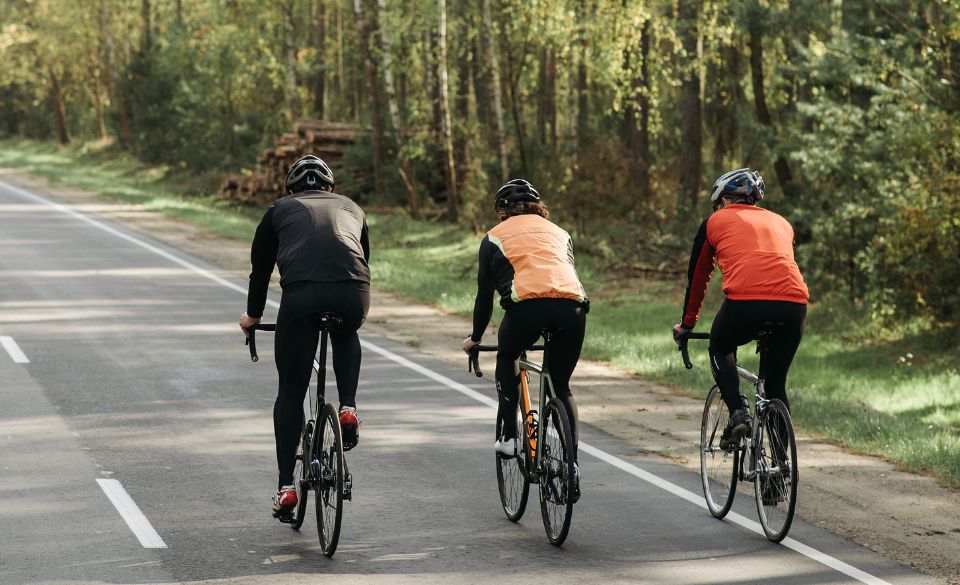
Why Does Cycling Reduce Bone Density: Cycling and Bone Density
Page Contents
Cycling is a popular and enjoyable physical activity that offers numerous health benefits. It is a low-impact exercise that provides cardiovascular conditioning, improved muscle strength, and enhanced joint flexibility. However, concerns have been raised regarding its impact on bone density. Some studies suggest that prolonged cycling may lead to reduced bone density in certain individuals. In this article, we will explore the intricate relationship between cycling and bone density, shedding light on the factors that can influence this relationship.
Understanding Bone Density
Bone density refers to the measure of mineral content within bones, reflecting their strength and resilience. It is an essential aspect of bone health and plays a significant role in determining an individual’s susceptibility to fractures and conditions like osteoporosis.
Bones are composed of a dense matrix of collagen fibers and minerals, primarily calcium and phosphate, which give them their strength and hardness. Throughout life, bones undergo a process called remodeling, which involves a balance between bone resorption (breakdown) and bone formation. This process ensures that damaged or old bone tissue is replaced with new, healthy bone.
Peak bone density is typically reached by early adulthood, around the age of 30. After that, bone density gradually starts to decline as part of the natural aging process. However, the rate of bone loss can be influenced by various factors, including genetics, hormonal changes, lifestyle choices, and certain medical conditions.
Maintaining optimal bone density is crucial to prevent fractures and maintain overall bone health. Adequate bone density is particularly important for older adults, as reduced bone density can increase the risk of osteoporosis, a condition characterized by weakened and brittle bones.
Weight-bearing activities, such as walking, running, dancing, and weightlifting, play a vital role in promoting and maintaining bone density. These activities subject the bones to impact and gravitational forces, which stimulate bone cells to build new bone tissue. The mechanical stress created during weight-bearing exercises triggers a signaling cascade that leads to bone remodeling, with osteoblasts (bone-building cells) laying down new bone and osteoclasts (bone-resorbing cells) removing old or damaged bone.
Additionally, factors like adequate intake of essential nutrients, including calcium, vitamin D, and protein, are crucial for bone health. Calcium provides the mineral component necessary for bone strength, while vitamin D aids in calcium absorption. Protein contributes to the structural integrity of bones and plays a role in the bone remodeling process.
Hormones, such as estrogen and testosterone, also influence bone density. Estrogen, in particular, plays a significant role in maintaining bone density in women. Reduced estrogen levels during menopause can accelerate bone loss and increase the risk of osteoporosis. In men, testosterone helps maintain bone density and muscle mass.
Other lifestyle factors that can affect bone density include smoking, excessive alcohol consumption, and chronic conditions like rheumatoid arthritis or certain hormonal disorders. These factors can impair bone remodeling and lead to decreased bone density over time.
Regular weight-bearing exercises, a balanced diet rich in essential nutrients, and a healthy lifestyle can all contribute to maintaining optimal bone density. However, it’s important to consult with a healthcare professional for personalized advice, especially if you have specific concerns about bone health or are at higher risk for bone-related conditions.
The Role of Weight-Bearing Activities
Weight-bearing activities create an impact or gravitational force on the skeleton, which stimulates bone cells called osteoblasts to build new bone tissue. These activities put stress on the bones, prompting them to adapt and become stronger over time. The repeated loading and unloading of weight-bearing exercises help increase bone density and reduce the risk of osteoporosis.
In contrast, non-weight-bearing activities like cycling do not provide the same level of impact on the bones. While cycling engages the muscles and provides cardiovascular benefits, the lack of direct loading on the bones limits its impact on bone density. The absence of gravitational force reduces the stimulus for bone remodeling and adaptation, which can lead to a lesser increase in bone density compared to weight-bearing exercises.
However, it is essential to note that while cycling may not have the same impact on bone density as weight-bearing activities, it still offers numerous health benefits and can be a valuable part of a well-rounded fitness routine. Combining cycling with weight-bearing exercises, resistance training, and a balanced diet rich in nutrients like calcium and vitamin D can help maintain and improve bone density, reducing the risk of bone-related issues.
Why Does Cycling Reduce Bone Density
Cycling itself does not directly reduce bone density. In fact, cycling is considered a low-impact exercise that is beneficial for cardiovascular fitness and muscular endurance. However, there are several factors associated with cycling that can contribute to a reduction in bone density in certain individuals. Let’s explore these factors:
Lack of Weight-Bearing Impact: Cycling is a non-weight-bearing activity, meaning that the bicycle supports the majority of the rider’s body weight. Unlike weight-bearing exercises such as running or jumping, which put direct stress on the bones, cycling does not provide the same mechanical loading required to stimulate bone formation. Without this impact, bones may not receive the necessary stimulus to maintain or increase their density over time.
Reduced Mechanical Stress: The reduced mechanical stress on bones during cycling can lead to decreased bone density. While the cardiovascular and muscular benefits of cycling are significant, bones require a certain level of stress to adapt and become stronger. The absence of this stress on bones during cycling can result in lower bone density, particularly in individuals who primarily engage in cycling and do not incorporate weight-bearing exercises into their routine.
Limited Variety of Movements: Cycling involves repetitive motions that primarily work the lower body, particularly the quadriceps, hamstrings, and calves. While these muscles become stronger and more conditioned through cycling, other muscle groups and bones may not receive adequate stimulation. A lack of variety in movements can limit the overall impact on bone density, as bones require a range of forces and stresses from various directions to maintain their strength.
Potential Hormonal Factors: Long-distance cyclists, especially female athletes, may experience hormonal imbalances that can contribute to reduced bone density. Intense training, low body fat levels, and irregular menstrual cycles can lead to decreased estrogen levels, which are essential for bone health. Estrogen helps regulate bone turnover and stimulates bone formation. Insufficient estrogen levels can accelerate bone loss and increase the risk of osteoporosis.
Nutritional Considerations: Nutritional factors can also play a role in bone health and density. Cyclists who do not consume a balanced diet, particularly one that includes adequate calcium, vitamin D, and other essential nutrients, may be at a higher risk of reduced bone density. Calcium and vitamin D are crucial for bone mineralization and maintenance. Insufficient intake of these nutrients can impair bone health and contribute to lower bone density.
It is important to note that the impact of cycling on bone density varies from person to person. Factors such as age, genetics, overall physical activity levels, diet, and lifestyle choices can also influence bone health. To mitigate any potential negative effects on bone density, cyclists can incorporate weight-bearing exercises, such as walking, jogging, or strength training, into their fitness routine. Additionally, maintaining a balanced diet and addressing any hormonal imbalances are essential for supporting optimal bone health. Consulting with a healthcare professional or a sports nutritionist can provide personalized guidance to maintain bone density while enjoying the benefits of cycling.
Factors Influencing the Relationship
Load-Bearing Elements: Although cycling may not be weight-bearing, certain elements can still influence bone density. For instance, standing on pedals, maneuvering over uneven terrains, or cycling uphill can impose additional stress on bones, offering some degree of weight-bearing effect. This can help stimulate bone formation and mitigate any potential negative impact on bone density.
Intensity and Duration: The intensity and duration of cycling play a crucial role in bone health. Engaging in moderate-intensity cycling for shorter durations may not have a significant impact on bone density. However, long hours of intense cycling, such as in professional cyclists, could potentially lead to reduced bone density. These individuals often have low body fat, low estrogen levels (in the case of female athletes), and inadequate nutritional intake, all of which can contribute to bone loss.
Cross-Training and Resistance Exercises: Incorporating weight-bearing and resistance exercises into a cyclist’s training regimen can help counterbalance any potential negative effects on bone density. Strength training, weightlifting, or exercises like stair climbing can stimulate bone formation and preserve bone density, even if cycling remains the primary activity.
Nutrition and Hormonal Factors: Proper nutrition, including sufficient calcium and vitamin D intake, is vital for maintaining bone health. Additionally, hormonal factors, such as low estrogen levels in women, can contribute to bone loss. Adequate nutrition and hormonal balance are crucial considerations for cyclists to prevent bone density reduction.
Final Words
While cycling is a fantastic form of exercise with numerous benefits, it is important to be aware of the potential impact on bone density. The relationship between cycling and bone density is complex, influenced by factors such as load-bearing elements, intensity, duration, cross-training, nutrition, and hormonal factors. Cyclists should adopt a comprehensive approach to their training, incorporating weight-bearing activities and resistance exercises, ensuring proper nutrition, and considering hormonal balance. By doing so, cyclists can mitigate any potential negative effects on bone density and continue to enjoy the countless advantages of this wonderful sport while maintaining optimal bone health.



